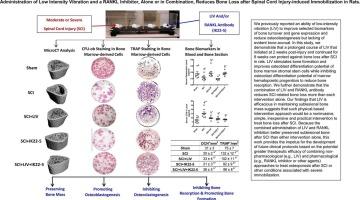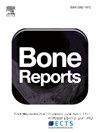单独或联合使用低强度振动和 RANKL 抑制剂可减少脊髓损伤引起的大鼠固定后的骨质流失
IF 2.6
Q3 ENDOCRINOLOGY & METABOLISM
引用次数: 0
摘要
我们以前曾报道过低强度振动(LIV)能够改善选定的骨转换生物标志物和基因表达,减少破骨细胞生成,但缺乏明显的骨累积。在这项研究中,我们证明了从受伤后 2 周开始并持续 8 周的长期低强度振动疗法可以防止大鼠在 SCI 后出现骨质流失。LIV 可刺激骨形成,提高骨髓基质干细胞的成骨细胞分化潜能,同时抑制骨髓造血祖细胞的破骨细胞分化潜能,从而减少骨吸收。我们进一步证明,LIV 和 RANKL 抗体的组合比单独使用两种干预措施更能减少 SCI 相关骨质流失。我们的研究结果表明,LIV 能有效维持局部骨量,这表明这种以物理为基础的干预方法是治疗 SCI 后骨质流失的一种无创、简单、廉价且实用的干预方法。由于联合施用 LIV 和 RANKL 抑制剂比单独施用其中一种干预措施能更好地保护 SCI 后的皮下骨质,因此这项研究为未来临床方案的开发提供了动力,而未来的临床方案将基于非药物疗法(如 LIV)和药物疗法(如 RANKL 抑制剂或其他药物)相结合的潜在更大疗效,以治疗 SCI 后或其他与严重固定相关的骨质疏松症。本文章由计算机程序翻译,如有差异,请以英文原文为准。

Administration of low intensity vibration and a RANKL inhibitor, alone or in combination, reduces bone loss after spinal cord injury-induced immobilization in rats
We previously reported an ability of low-intensity vibration (LIV) to improve selected biomarkers of bone turnover and gene expression and reduce osteoclastogenesis but lacking of evident bone accrual. In this study, we demonstrate that a prolonged course of LIV that initiated at 2 weeks post-injury and continued for 8 weeks can protect against bone loss after SCI in rats. LIV stimulates bone formation and improves osteoblast differentiation potential of bone marrow stromal stem cells while inhibiting osteoclast differentiation potential of marrow hematopoietic progenitors to reduce bone resorption. We further demonstrate that the combination of LIV and RANKL antibody reduces SCI-related bone loss more than each intervention alone. Our findings that LIV is efficacious in maintaining sublesional bone mass suggests that such physical-based intervention approach would be a noninvasive, simple, inexpensive and practical intervention to treat bone loss after SCI. Because the combined administration of LIV and RANKL inhibition better preserved sublesional bone after SCI than either intervention alone, this work provides the impetus for the development of future clinical protocols based on the potential greater therapeutic efficacy of combining non-pharmacological (e.g., LIV) and pharmacological (e.g., RANKL inhibitor or other agents) approaches to treat osteoporosis after SCI or other conditions associated with severe immobilization.
求助全文
通过发布文献求助,成功后即可免费获取论文全文。
去求助
来源期刊

Bone Reports
Medicine-Orthopedics and Sports Medicine
CiteScore
4.30
自引率
4.00%
发文量
444
审稿时长
57 days
期刊介绍:
Bone Reports is an interdisciplinary forum for the rapid publication of Original Research Articles and Case Reports across basic, translational and clinical aspects of bone and mineral metabolism. The journal publishes papers that are scientifically sound, with the peer review process focused principally on verifying sound methodologies, and correct data analysis and interpretation. We welcome studies either replicating or failing to replicate a previous study, and null findings. We fulfil a critical and current need to enhance research by publishing reproducibility studies and null findings.
 求助内容:
求助内容: 应助结果提醒方式:
应助结果提醒方式:


